A unique mission concept known as Interstellar Probe would venture beyond the solar system and probe our neighborhood environment.
Johns Hopkins APL
An exciting mission spanning the next half century of space exploration may leave Earth on a path out of the solar system in the next decade. Researchers from the Johns Hopkins University Applied Physics Laboratory revealed a formal proposal for the Interstellar Probe at the American Geophysical Union meeting held in New Orleans, Louisiana at the end of 2021. The mission would give us a big-picture view of the Sun's neighborhood.
The Interstellar Probe, which could be part of the upcoming 2023–2032 Solar and Space Physics Decadal Survey that identifies the community's funding priorities, would be the first spacecraft to explicitly designed to probe the interface of the Sun's protective bubble, known as the heliosphere, and the rarefied gas around the Sun, the local interstellar medium. Such observations are only possible from beyond the influence of the solar system. Plus, the mission might visit a few interesting destinations along the way.
The Path Out of the Solar System
The proposal would see the Interstellar Probe mission launching on a Space Launch System (SLS) Block 2 heavy rocket in the mid-2030s. (The inaugural launch of the SLS-1 Block 1 is set to launch this year on March 12th on the Artemis 1 mission.)
To reach a range of 380 astronomical units (a.u.) from the Sun within 50 years, the mission will need to be a fast one: Interstellar Probe will need to leave Earth at up to 60,000 kilometers (over 37,000 miles) per hour, departing the Earth-Moon system faster than New Horizons did in 2006.
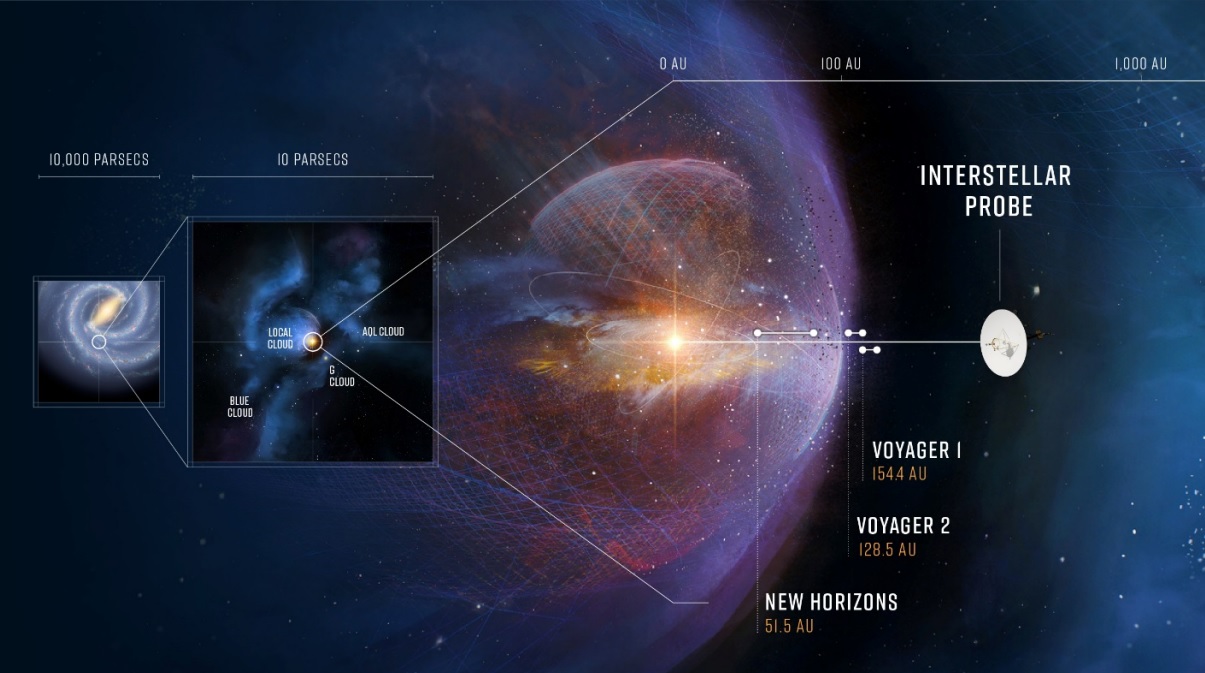
Johns Hopkins APL
The spacecraft will likely make a passive or powered gravitational assist flyby past Jupiter to pick up speed. A Jupiter-assist launch window opens once every 13 months, setting constraints on when the probe can launch.
Ironically, an earlier proposed approach to accelerate the probe would have involved what’s known as an Oberth maneuver, which would send the probe on a blistering pass just under half a million miles from the surface of the Sun. That would set up a gravitational slingshot to fling the probe out of the solar system.
That trajectory would have involved several firsts, including the closest pass near the Sun, the fastest speed ever achieved — not to mention the first use of an Oberth maneuver by a spacecraft. It would also have required the addition of a massive sunshield. Ultimately, the team decided against this approach.
“The Oberth maneuver adds little speed in comparison with a Jupiter gravity assist, but poses a high mission risk,” says Cocoros. “Additionally, the Jupiter gravity assist option puts us in a sweet spot in terms of speed to do the science the community has identified as critical.”
Moving at an unprecedented speed, Interstellar Probe could reach the termination shock, at 90 a.u., in just 12 years. The mission's 50-year extended mission could span hundreds of a.u. past the heliopause, deep into the interstellar medium. Its lifetime would span nearly five 11-year cycles of solar magnetic activity.
Though Interstellar Probe builds on the legacy of other spacecraft that have or will escape the solar system, including Pioneers 10 and 11, New Horizons, and Voyagers 1 and 2, Interstellar Probe will be the first mission specifically be designed to probe the outer solar environment and the local interstellar medium.
“The beauty of the Interstellar Probe is not in reaching any one point but the journey it will take through the solar system,” says Alice Cocoros (Johns Hopkins APL). “We will begin taking measurements shortly after launching and will continue doing so for the duration of the 50-year mission . . . far beyond the reach of any spacecraft that has flown before. The continuity of these measurements throughout the journey will provide insightful information to answer some of the most pressing questions in space physics.”
Science Objectives
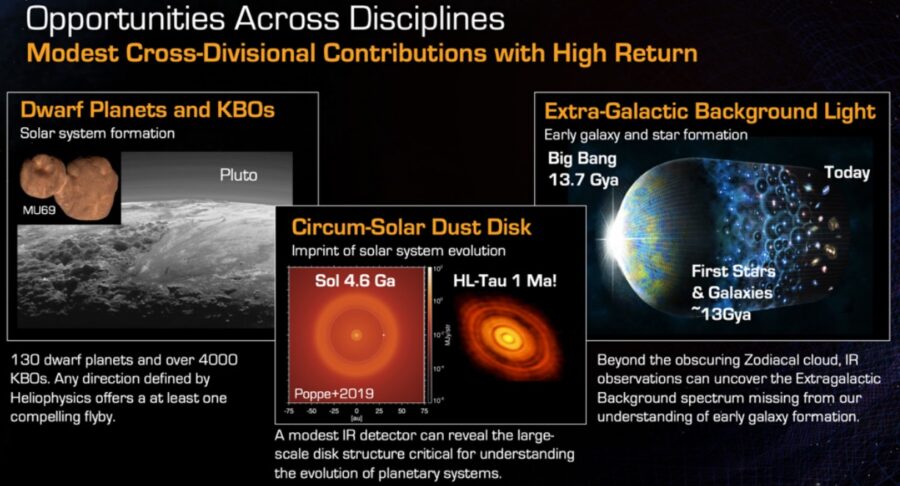
Johns Hopkins APL
The goal of Interstellar Probe is to understand and characterize our protective bubble and its place in the environment around it. But as long as we’re sending a once-in-a-generation mission out of the solar system, it makes sense to carry out as much science as possible along the way. To this end, the mission will have several objectives.
The mission's primary goal is to understand the process shaping the heliosphere relative to the local interstellar environment, including the effects of the solar cycle. Researchers want to quantify the properties of the gas and dust around the Sun. They also want to measure the bowshock created as the solar system moves through the interstellar medium; the Voyagers passed through this boundary but produced more questions than they answered. Unlike the Voyagers, this mission would carry instruments to investigate particles of all sorts inside, along, and outside this boundary, including ionized plasma, dust, neutral atoms, energetic particles, and cosmic rays.
Critically, a launch in the late 2030s would allow the spacecraft to exit the solar heliosphere close to the “ram direction” into the interstellar wind, while also placing the mission far enough to the side to see the heliosphere's global structure via detections of energetic neutral atoms. The latter observations could settle the ongoing debate on where the heliosphere is shaped more like a crescent or more like a tadpole, with a tail trailing in the Sun's wake.
Farther out, the mission will seek to understand our solar system’s current position amongst several local interstellar "clouds." These clouds are regions of the interstellar medium that have slightly more dust and gas (though they're still more rarefied than the best vacuum on Earth).
Nevertheless, the clouds, as well as pressure from nearby supernovae, affect the size and shape of the heliosphere, at times squeezing it inward enough to remove some of its protection. The Sun has been traversing one cloud, unimaginatively named the Local Interstellar Cloud, for the last 60,000 years, but it may be on the edge. The solar system is expected to exit this cloud in just 2,000 years, and it may already be in contact with the next one. The spacecraft would use four 50-meter radio antennas to measure plasma electron density to understand our place among these clouds. Understanding their effect on cosmic ray flux is crucial to understanding their impact on the evolution of life on Earth.
“Our heliosphere is the only habitable astrosphere we know today,” says Elena Provornikova (Johns Hopkins APL). “How it is formed, how it evolved in the past and will evolve in the future during its travel in the galaxy, how this evolution affects atmospheric and surface habitability of the planets is yet to be discovered with the Interstellar Probe mission.”
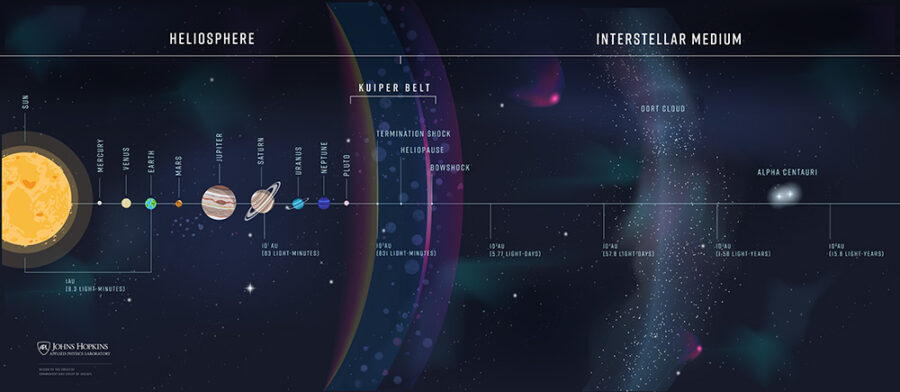
Johns Hopkins APL
In addition to this broad primary goal is the supporting objective of exploring Kuiper belt objects while en route in an effort to understand planetary origins. The initial report lists 10 flyby candidates, including 50000 Quaoar, 225088 Gonggong, and 90482 Orcus.
How many objects the probe can reach depends on when it launches. For example, a 2040 launch would put it on a trajectory to fly past Quaoar, a distant world that seems to be rapidly losing volatiles. That flyby window would also send the mission toward a vast ribbon of energetic neutral atoms streaming across the boundary of the heliosphere, as seen by NASA’s Interstellar Boundary Explorer (IBEX) in 2013. The probe could provide views complementary to those of IBEX and the Interstellar Mapping Acceleration Probe (IMAP) from their positions at 1 a.u.
“A potential flyby of a small dwarf planet or an object in the Kuiper Belt will enable exploration of a world never visited before, and provide leaps in understanding the diversity of these bodies in the solar system,” says Provornikova.
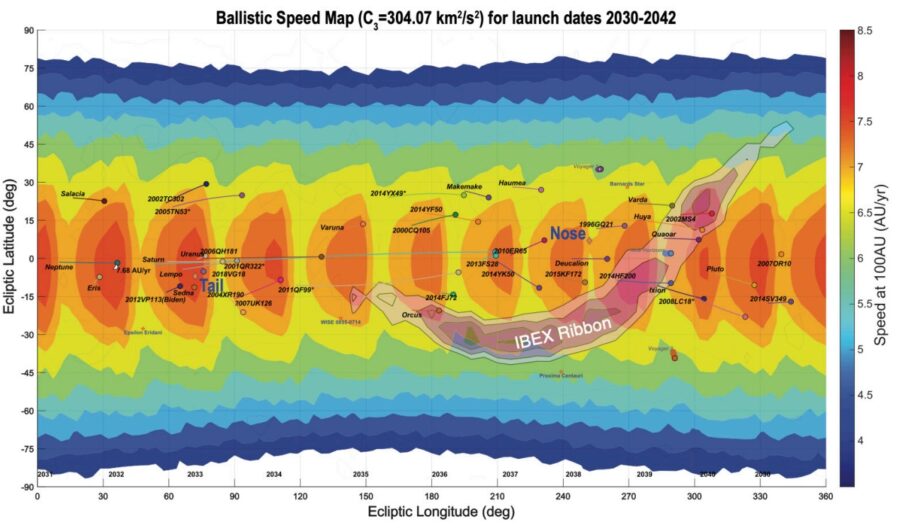
Johns Hopkins APL
A second supporting goal would see the Interstellar Probe performing astrophysics observations that can only be done outside of the solar system. One prime example is understanding galaxy and star formation via extragalactic background light. This diffuse light from unresolved stars and galaxies can only be seen beyond the obscuring effects of the zodiacal light, produced as dust in the inner solar system scatters sunlight. New Horizons has already made observations of this background on its outbound journey.
To support these goals, the mission would explore the inner heliosphere, between 1 and 90 a.u. during its first 12 years. Then it would enter the heliosheath, around 90 to 120 a.u. for the next four years, before entering the interstellar medium beyond about 120 a.u. The mission is expected to take 50 years to reach 380 a.u. from the Sun. For context, the most distant spacecraft (Voyager 1) is currently 155 a.u. distant. Voyager 2 (the most distant operational spacecraft) is 129 a.u. out. It will probably fall silent in a decade or so, passing the distinction to New Horizons, currently at 52 a.u..
Mission Design
The projected mission cost is $1.7 billion (projected in FY25 dollars, with cost from design through launch but not including rocket), with an additional $230 million per decade for operations.
Like other spacecraft escaping the solar system, the mission would incorporate a pair of next-generation plutonium-238-fueled Multi-Mission Radioisotope Thermoelectric Generators (MMRTG), which will provide decades of reliable power far from the Sun.
The mission will incorporate several instruments to measure properties of the outer solar system and the interstellar environment, but the final mission payloads will be dictated by the launch window and ensuing flybys. For communication, the probe will use the soon-to-be-upgraded Deep Space Network out to 70 a.u., before switching to the next-generation Very Large Array network, as outlined in the recent Astronomy and Astrophysics Decadal Survey, which should allow communication out to 1,000 a.u.
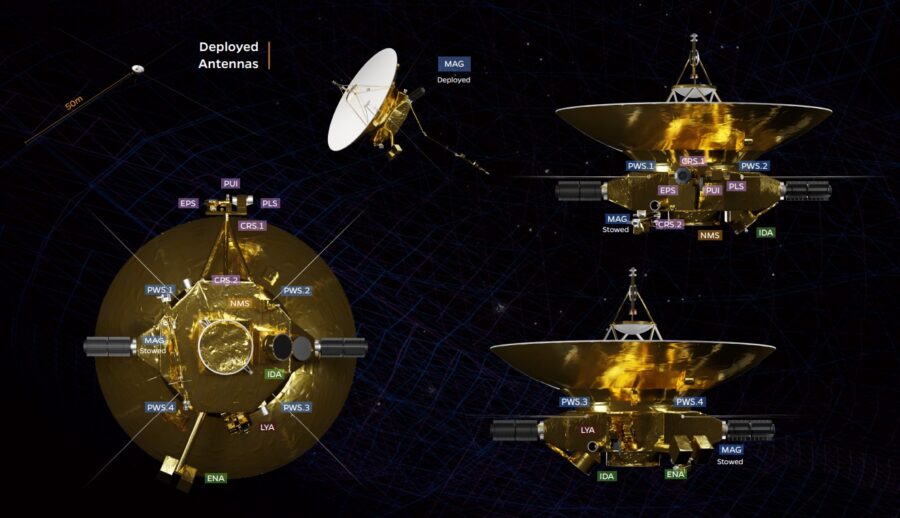
Johns Hopkins APL
The next hurdle for the mission is the Solar and Space Physics Decadal Survey, due out next year, which could select Interstellar Probe as a flagship mission. China also has a plan for a similar Interstellar Express mission or set of missions, possibly launching as early as 2024.
How much has our local astrosphere shaped our local galactic environment, and our home in it? With the breathtaking scope of the Interstellar Probe mission, we may know by the end of the century.
Read the entire mission concept report for Interstellar Probe here.
 1
1









Comments
David C
January 22, 2022 at 8:44 am
Since the Voyagers left the Solar System more or less as a happy side-effect of a "Grand Tour" mission to the outer planets, I've always wondered about the possibilities if leaving the Solar System were your _primary_ objective. For example, how fast could you get to Alpha Centaurii if that was your primary goal? Is there a theoretical upper speed limit? For instance, do you miss out on "gravity assist" if you're already going too fast? If I'm reading this article correctly, this Interstellar Probe mission aims for a compromise - fast enough to get somewhere interesting, slow enough to do science in the process - but if your science goals were different, how fast could you go?
You must be logged in to post a comment.
You must be logged in to post a comment.